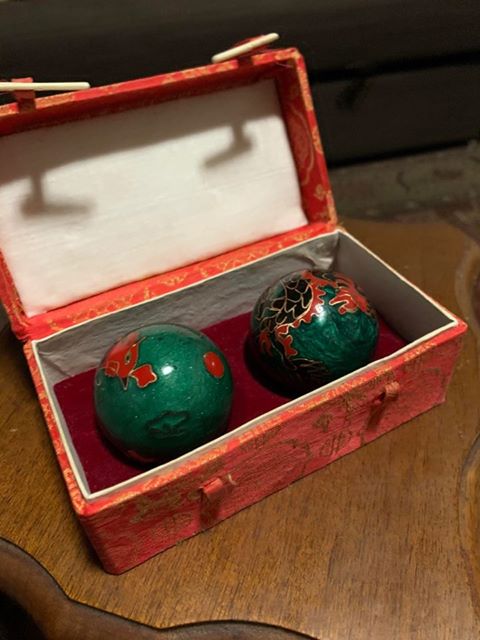
Baoding balls are a pair of relatively small balls, each small enough to be carried in one hand. They are also known as Chinese meditation balls, workout balls, or even Zen meditation balls.
Baoding balls are commonly employed by continually rolling two or more of them in your palm so that their relative positions are constantly changing. The goal of this exercise is to increase finger dexterity, promote relaxation, and speed the rehabilitation of injured muscles and motor abilities.
These balls are known as “meditation balls” since it is said that they strengthen your hand muscles while enhancing brain function and reducing stress.
The Baoding balls often keep touch when they are turned, according to beginners who use them. Nevertheless, with enough experience, we can spin and control these balls without letting them collide.
Table of Contents
History Behind The Baoding Balls
Despite the fact that the hollow Baoding balls we are familiar with today first emerged during the Ming Dynasty (1368–1644 CE), the history of Baoding balls dates back to the Han Dynasty (26-220 CE). The Baoding city in Heibei province, where the balls are thought to have originated, is where the term “Baoding balls” originates.
But walnuts, which are used to practise the hands, rather than iron balls, were depicted in the Han Dynasty archives. Iron balls did not replace these walnuts until the Sung Dynasty (960–1279 CE), several centuries later. At this time, Chinese acrobats and martial artists alike train using Baoding balls as weapons. It is thought that the Baoding balls gave them stronger and more effective abilities.
The hollow Baoding balls we are familiar with today were developed only during the Ming Dynasty, as was previously indicated. Emperor Jia Jing (1522–1567 CE) is thought to have instructed his court to examine the effects of the iron balls, and as a result, a technique for making hollow balls (which are lighter and simpler to operate) rather than the solid iron design was developed.
Emperor Qianlong (1736–1799) was advised by his doctor to train his hands with the Baoding Balls every day during the Qing Dynasty. He developed a fondness for these Baoding balls, which helped them gain cultural acceptance. The fact that Qianlong lived the greatest life span of any emperor in Chinese history helped to popularise the usage of Baoding balls for health purposes.
The Baoding balls were widely known at this time and were prized by many as one of the Three Treasures of Baoding (Baoding balls, potherb mustard, and flour sauce). Baoding balls have undergone several design improvements over the years, including the process of enclosing a smaller ball with a spring to create a nice melodic chime.
The Baoding balls now available in a variety of sizes as well as patterns and finishes, such as chrome-plated and cloisonne steel.
Baoding balls nowadays are available in a range of quality and pricing points: High-quality baoding balls include those made of gemstones, copper, and solid steel or iron. Gemstone balls are especially well-liked since it is thought that they have metaphysical properties. High-quality balls may also have exquisite carvings and designs.
The Baoding balls have been referred to by a variety of titles over its lengthy history, including Chinese stress balls, Chinese medicine balls, Chinese workout balls, dexterity balls, meditation balls, harmony balls, and simply Chinese balls. Some of these titles allude to the advantages that these balls offer, which we shall go over below.
Baoding Balls: Uses and Advantages
The Baoding balls have been in use by the Chinese for generations. Baoding balls are still occasionally recommended by doctors to patients who have hand/arm injuries or weariness today, not just in China (including post-surgery recovery). This is due to the theory that the Baoding balls stimulate several meridian pressure points in the hand’s palm.
In traditional Chinese medicine, we also acknowledge the existence of Chi (or Qi), the life force that courses through the body along pathways we refer to as meridians. Baoding balls are said to stimulate these meridian points to replenish the flow of chi. The fingers are connected to all of the essential organs in the body, including our brain, by these meridian lines.
The revolving action of the Baoding balls, despite their primary application in the hands and fingers, may be advantageous for the entire body. The patient’s internal energy flow is improved by the pressures produced by the motions of the Baoding balls, which can result in the following advantages:
- Stress and anxiety relief
- easing joints and muscles
- enhanced mental health and decreased memory loss
- Enhanced slumber quality
Your brain is actively involved when your hand muscles rotate the Baoding balls, resulting in a focused awareness and mindfulness (mind-body connection) to prevent distractions. Although the Baoding balls are sometimes referred to as “meditation balls,” as was previously said, they are rarely utilised in formal sitting meditation practice since they frequently cause distractions.
Try Evolve App to meditate and build your self esteem. The app has journeys that will help you lead a healthy life. The Evolve app is now live globally on Android & Apple, click here to try for free!
Simple Mindfulness Exercises-How To Make You More Peaceful
Daily Meditation- How to Practice and What are the Benefits?
Co-founder and brains at LeapX by C32 Media Labs
Mail at sarah@c32.media to connect with her.
